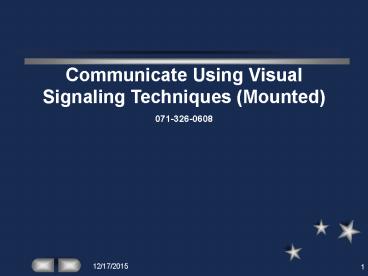Communicate Using Visual Signaling Techniques (Mounted) - PowerPoint PPT Presentation
1 / 25
Title:
Communicate Using Visual Signaling Techniques (Mounted)
Description:
Title: No Slide Title Author: Peter L. Millington Last modified by: Jason Blanchard Created Date: 4/13/1999 12:50:49 AM Document presentation format – PowerPoint PPT presentation
Number of Views:359
Avg rating:3.0/5.0
Title: Communicate Using Visual Signaling Techniques (Mounted)
1
Communicate Using Visual Signaling Techniques
(Mounted) 071-326-0608
2
Introduction
3
Visual Signaling Techniques
- (1) Hand and arm signals.
- (a) These are given while mounted - vehicle to
vehicle, and dismounted - from ground to vehicle
or ground to ground. Dismounted signals given
from ground to vehicle are normally referred to
as Ground Guide signals. - (b) These are used to communicate to either one
element or to an entire unit.\
4
Visual Signaling Techniques
- (2) Flag signals. These are used in the same
manner as hand and arm signals. - (3) Pyrotechnic signals. These are used, either
mounted or dismounted, to communicate to an
entire unit. - (4) Ground to air signals. These are used to
guide helicopter(s) to a landing point.
5
Dismounted Visual Signals
- (1) Day ground guide signals.
- (a) START ENGINES or PREPARE TO MOVE
- (b) STOP ENGINE
- (c) HALT or STOP
- (e) MOVE FORWARD
- (f) MOVE IN REVERSE (Backup)
- (g) CHANGE DIRECTION
6
Dismounted Visual Signals
- (h) NEUTRAL STEER (Tracked Vehicles)
- (i) INCREASE SPEED
- (j) LIGHTS ON - Point index finger of both hands
toward eyes. - (k) LIGHTS OFF
- (l) CLOSE DISTANCE BETWEEN VEHICLES AND STOP
- (m) RAISE RAMP
- (n) LOWER RAMP
7
Night ground guide signals
- Night ground guide signals are used during
periods of darkness or limited visibility.
Objects such as a flashlight with a filtered lens
or a chemlight are normally used to give signals.
Never use a bright light - it will give your
position to the enemy.
8
Night ground guide signals
- (a) START ENGINE
- (b) HALT, STOP (moving vehicles), or STOP ENGINE
(stationary vehicles) - (c) INCREASE SPEED
- (d) TURN
- (e) MOVE IN REVERSE (for vehicles which are not
moving) or SLOW DOWN (for vehicles which are
moving)
9
Rear ground guides
- Rear ground guides are always used when a
vehicle is moving in reverse or neutral steering. - (b) The rear ground guide is in command of
moving the vehicle when it is moving in reverse
and will give his visual signals according to the
direction he wants the front of the vehicle to
move.
10
Rear ground guides
- (c) The front ground guide is responsible for
relaying the signals given by the rear ground
guide to the driver of the vehicle. - (d) When the rear ground guide is giving a
command the front ground guide will create a
mirror image of the rear ground guides signals.
For example, when the rear ground guide is giving
the command Move in Reverse - Change Direction
Left
11
Mounted Visual Signals
- (1) Mounted visual signals are used to control
movement and give warning to either an entire
unit or a platoon size or larger element within
the unit. - (2) Track commanders execute the signals to
communicate messages between vehicles. - (3) When an action or movement is to be executed
by less than the total unit, the signaler will
point, if necessary, toward the elements of a
unit as an alert that a signal will follow.
However, when a movement or action is to be
executed by the entire unit the proper signal
should be preceded by the signal Attention.
12
Mounted Visual Signals
- (4) Signals are performed by hand and arm
signals or by the use of flags. - (5) Hand and arm signals to direct combat
formations.
13
Mounted Visual Signals
- (a) COIL
- (b) HERRINGBONE
- (a) CONTACT LEFT
- (b) CONTACT RIGHT
- (c) ACTION LEFT
- (d) ACTION RIGHT
- (g) AIR ATTACK
- (h) NBC ATTACK
14
Hand and arm signals to initiate movement
techniques.
- (a) TRAVELING
- (b) TRAVELING OVERWATCH
- (c) BOUNDING OVERWATCH or COVER MY MOVE
- (d) MOVE TO LEFT
- (e) MOVE TO RIGHT
15
Hand and arm signals to control vehicle
- (a) ATTENTION
- (b) I AM READY or READY TO MOVE. ARE YOU READY?
- (c) MOUNT
- (d) DISMOUNT or TAKE A PRONE POSITION
- (e) DISREGARD PREVIOUS COMMAND or AS YOU WERE
16
Hand and arm signals to control vehicle
- (f) I DO NOT UNDERSTAND
- (g) ADVANCE or MOVE OUT
- (h) OPEN UP
- (i) CLOSE UP
- (j) RIGHT/LEFT TURN -
- (k) BUTTON UP
- (l) UNBUTTON
- (m) MESSAGE ACKNOWLEDGED
17
Flag signals
- Flag signals are used to communicate messages
between vehicles over distances which are to
great to use standard hand and arm signals. The
use of flags must be strictly monitored to
prevent the enemy from detecting your position.
18
Flag signals
- (a) MOUNT - With the
- (b) DISMOUNT
- (c) DISMOUNT AND ASSAULT
- (d) ASSEMBLE or CLOSE.
- (e) MOVE OUT
- (f) NBC HAZARD PRESENT.
19
(No Transcript)
20
(No Transcript)
21
(No Transcript)
22
(No Transcript)
23
(No Transcript)
24
(No Transcript)
25
Any Questions?

